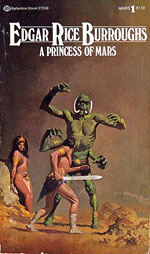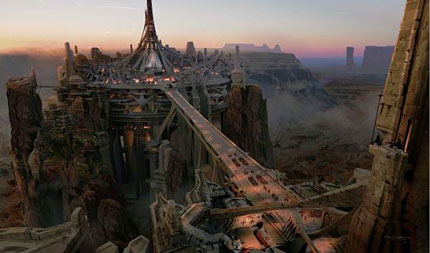
My visions of Edgar Rice Burrough‘s Barsoom are based on the art Gino D’Achille did for the 1970s Ballantine editions.
I had read the first couple of the John Carter books in high school, but hadn’t found the remaining books in the series. A few years later, I discoverd that the college bookstore had the rest of the books featuring D’Achille’s covers — so I naturally snapped them up. By this time, the new Ballatine books were sporting covers by Michael Whelan, which didn’t match the images in my mind’s eye.
I’ve written previous about how movies don’t often match what we imagine when we read a story. So I won’t repeat that here.
But I will say that I’m intrigued by what I see and read about the upcoming John Carter (no mention of Mars) movie over at Hero Complex, a blog on the Los Angeles Times website.
The director, Andrew Stanton, has an impressive record with Pixar. He can tell a story very well. I hope that carries over to a live-action John Carter.

What worries me more is what he says about the story:
If it had been a perfect piece of literature I would have been a little too intimidated to tweak it. I had every desire to make it feel on the screen like how it made me feel reading the book, and to me that’s the most important thing. And I thought the only way to get there honestly was to read the book, come up with a bunch of ideas and never look at the book again. And from there just to look at what organically came together. What was really fascinating: I finally let myself read the book after the script was green-lit and all of these things that, in my mind, I was starting to give myself credit for coming up with were in there. [Laughs] But it made me feel very confident that we took it apart and put it back together and it held.
Based on his record, I’m willing to give him the benefit of the doubt. He comments earlier that the first novel in the series reads like a movie serial, with cliffhanger after cliffhanger until you get to the end. I have to agree (and, truthfully, that’s the way a lot of pulp adventures read).
And I’m encouraged by this comment:
We said, “We’ll treat it this way, we won’t treat it like some fantasy being fulfilled by a fan.” We tried to make it feel like we’re going with the story of what really happened. This is how it was, this is how those cultures really existed. That was one of the many levels, for instance, that I enjoyed “The Lord of the Rings” on. One of the similarities between Tolkien and Burroughs is that they came across to the reader as if they had done so much travel research; they seemed like they had gone to these places and documented the flora and the fauna and the architecture and the culture and the rules. They did it in ways that someone who visited those places would have done it.
John Carter is in postproduction now and will hit the screens March 9, 2012. Until then, I’ll keep my fingers crossed.


I’ll be interested to see this, too. My favorite John Carter novels are “Gods of Mars” and “Warlord of Mars.” Those were issued in the 70s in a single volume with a Frank Frazetta cover. Very cool. But I doubt if they could fit all of that in one movie.